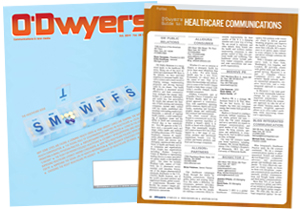 Inbound marketing, loosely defined as the art and science of drawing visitors to your organization on their own terms (versus obtrusively pushing your messages onto them), represents a seismic shift in the way businesses develop content and market themselves, as well as in the way audiences access and process information.
Inbound marketing, loosely defined as the art and science of drawing visitors to your organization on their own terms (versus obtrusively pushing your messages onto them), represents a seismic shift in the way businesses develop content and market themselves, as well as in the way audiences access and process information.
If recent developments are any indication, the healthcare marketplace appears to be embracing inbound marketing. As noted on the influential website Dose of Digital, numerous drug companies and patient advocacy groups are utilizing digital media channels (e.g., blogs, Facebook, Twitter, LinkedIn, YouTube, Pinterest) to deliver content and attract target audiences. Notably, the vast majority of inbound tactics undertaken by the commercial life science industry focus on unbranded content, such as Novo Nordisk’s Pinterest page.
Similarly, the patient advocacy community is increasingly employing inbound strategies to raise disease awareness, as exquisitely illustrated by the Melanoma Research Foundation’s Get Naked campaign and, of course, the ALS Ice Bucket Challenge.
Inbound marketing offers our healthcare communication clients a breath of fresh air that will invigorate, complement, and in some cases replace traditional PR tactics. Each of the sectors that comprise our client ranks — pharmaceuticals/biotech, medical technology, devices/diagnostics, academia, patient advocacy, and healthcare policy — can amp-up their traditional PR programming with inbound tactics that deliver measurable ROI.
|
|
Thankfully for us PR folks, embracing an inbound strategy is about providing target audiences with personalized, high-value content. Similar to traditional analog PR tactics, with Inbound, content is king. Inbound is about attracting and establishing relationships with target audiences via long-form story telling versus intrusive, paid promotional tactics that are more akin to advertising disciplines.
Communications experts can benefit from incorporating inbound strategies that demonstrate ROI. Proving that you are increasing return is important for several reasons, most notably the positive impact on marketing budgets. Among respondents to the HubSpot’s 2014 State of Inbound Marketing survey, no single factor had a greater impact on budget — positive or negative — than did “past success with inbound.”
Improving ROI may even safeguard your budget against factors beyond your control, like the economy itself.
Here’s a quick look at the four key elements of inbound marketing:
Website traffic generation
Successfully generating traffic to a website requires a combination of tools working together. For most inbound marketers, the most efficient traffic-generating tools include search engine optimization, blogging and social media sharing engagements.
SEO places keywords in the backend code and in on-page content so that search engines preferentially identify and navigate to one’s website. To be effective, SEO must be supported by regular monitoring of website traffic and rankings, as this can expose weak keywords and phrases while identifying optimal keywords and phrases.
Blogging can augment a company’s online presence by providing additional pages of content, hence creating more opportunities to ascend search engine rankings. Most corporate websites offer a limited number of pages describing the company, its business and products. Blogging offers an endless opportunity for new content pages on a variety of topics that resonate with a company’s customer base. Blogs should also include sharing functionality to amplify the value of the content.
Lead generation
Generating traffic is only part of the inbound marketer’s goal. One must also turn traffic into leads. Lead generation can be enhanced through the development and implementation of “premium offers,” landing pages and call-to-action buttons. Whereas blogs are public-facing and available to all, premium offers like webinars and e-book downloads require visitors to enter their email addresses on a landing page in order to obtain the desired content. When a visitor fills out the form to access this content, a lead is created.
Businesses can leverage their content-specific expertise, as well as their knowledge of their prospects, to build out both an electronic and a human follow-up process. This is online lead generation at its simplest and most effective. For businesses seriously considering their website as an enabler of growth, the marketing efficiency behind these tactics is undeniable. And from a sales or “awareness” perspective, leads generated from premium educational, customer-targeted content can be hugely productive, based on how thoroughly they fulfill a prospect’s needs.
Lead conversion
All who download a company’s content need to be followed up with, either by a human or by an automated system. Part of that follow-up needs to consist of deeper content offerings, which invite leads to access more of a company’s content. Prospects can self-qualify by opting into such offers, which can be presented through email marketing and lead nurturing.
As an example, UCB Pharma provides a form field, to encourage patients with Crohn’s disease to opt-in to receive more information via its sponsored website.
Premium content helps solve customers’ problems and fulfill their needs. Lead nurturing and segmented email campaigns can be used to target leads more efficiently after they have converted on your site, and to trigger a series of actions intended to generate sales.
Analysis and measurement
The Web’s massive footprint allows for almost total traceability, which means all the tactics and campaigns you manage and build are instantly measurable. This allows for easy replication of success — but only if you are watching the metrics that most directly impact your marketing goals. Traceability can also enable fast failure, allowing the marketer to jettison unsuccessful tactics before they inflict too much strain on the budget.
The set of numbers a company needs to watch may differ from one campaign to the next, depending on the services it offers and the consumer behaviors it seeks to affect. If a company is trying to increase online awareness and drive more traffic to its site, its metrics will need to answer the following types of questions:
-Has the site’s overall traffic increased?
-Have our blogging efforts improved the rankings for the keywords inherent to our core business?
-Have social media and link-building efforts translated into a worthwhile amount of referral traffic?
-If lead generation and conversion is the goal, a company can monitor other metrics, namely:
-Do our webinars attract sufficient numbers of registrants and live attendees?
-For our ebook landing pages, what percentage of page visits convert into downloads?
-What do the numbers tell us in terms of how to improve our lead generation efforts?
By building a process that utilizes inbound marketing’s four core elements, we can improve the methods by which we target and communicate with our customers. Moreover, inbound marketing enables our customers to find us, to communicate directly with us and, importantly, to share their experience with others. Additionally, inbound marketing tools are valuable because they are measurable, scalable and repeatable.
The future of healthcare communications depends upon the strategic integration of inbound and traditional PR tactics. Repurposing traditional PR content for use via inbound marketing can make marketing/PR spending more cost-effective while monetizing vast amounts of otherwise one-dimensional content. Press releases, brochures, slides and video can be exploited through all available digital channels. The timely implementation of fast-to-fail communication programs will enable maximization of the most effective tactics and discontinuation of the least effective.
To be sure, our clients will need to be educated about the benefits of inbound marketing strategies. We PR professionals must therefore shoulder the responsibility of breaking out of our stuffy analog boxes and breathing the fresh air of inbound marketing.
* * *
John F. Kouten is CEO of JFK Communications.



 Lo Isidro, senior director at Real Chemistry with more than a decade of strategic communications and PA experience, has joined Narrative Strategies.
Lo Isidro, senior director at Real Chemistry with more than a decade of strategic communications and PA experience, has joined Narrative Strategies. Nelson Fernandez, former North American chair of APCO Worldwide and managing director of Burson-Marsteller, has joined Volunteers in Medicine Berkshires as director of communications and PA.
Nelson Fernandez, former North American chair of APCO Worldwide and managing director of Burson-Marsteller, has joined Volunteers in Medicine Berkshires as director of communications and PA. Lilit Bargar, who was most recently an EVP in the healthcare practice at Weber Shandwick, comes on board at GCI Health as EVP, corporate practice lead.
Lilit Bargar, who was most recently an EVP in the healthcare practice at Weber Shandwick, comes on board at GCI Health as EVP, corporate practice lead.
 Five ways that successful thought leaders are made.
Five ways that successful thought leaders are made.


 Have a comment? Send it to
Have a comment? Send it to 
No comments have been submitted for this story yet.